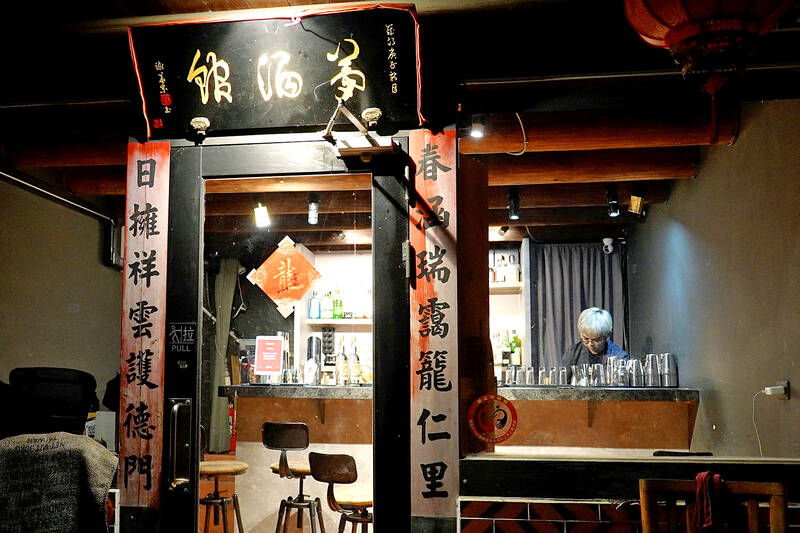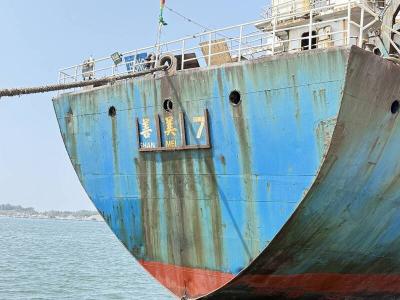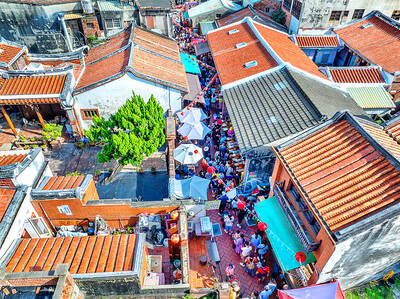On Kinmen Island, less than an hour’s boat ride from the cities of Xiamen and Quanzhou in China’s Fujian Province, bar owner Powei Lee draws crowds by blending the tiny island’s battle-scared past into cocktails.
During the height of the Cold War, Chinese and Taiwanese forces regularly clashed over Kinmen — then mostly known in English as Quemoy — and other islets controlled by Taiwan along China’s coast.
While today Kinmen is a fashionable tourist destination, drawing visitors to see its endangered otters and stark natural beauty, it has been back in the news after China last week included areas round the island for its latest war games near Taiwan.

Photo: Joyce Zhou, Reuters
Kinmen native Lee’s cocktails at his Vent Bar showcase Kinmen’s unique flavor, such as the local fire water, kaoliang, made with sorghum grown on the island.
Lee, 31, has designed one cocktail inspired by an extensive propaganda campaign that followed fighting in 1958, when Taiwanese forces fended off a Chinese attack on Kinmen, whose closest point is only about 2km from China.
Called “Pick and Eat,” the cocktail is made with a base of soy milk, ginger and whiskey, topped with cookies.
“Back then, the two sides would drop propaganda leaflets, each trying to show that their side was doing better and urging the other to surrender,” he said.
“One of the things they would do besides the leaflets was to send over supplies like snacks and food, to show that the people were well-fed.”
Taiwan has controlled Kinmen, and the Matsu islands further up the coast, since the defeated Republic of China government fled to Taipei in 1949 after losing a civil war with Mao Zedong’s (毛澤東) communists.
Old bunkers, many now open to visitors, still dot Kinmen which is home to about 100,000 people, and Taiwan’s military maintains a substantial presence.
“I want them [the visitors] to be able to take away something even more meaningful than just typical souvenirs. If they can really feel that connection to the land, and understand the stories behind it, that’s going to be the best memento they can have from their time here in Kinmen,” Lee said.
Those visitors might be Taiwanese or from further afield — but generally not Chinese. Regular post-COVID-19-pandemic Chinese tourism to Taiwan has yet to resume, amid bickering between Beijing and Taipei.
Life in Kinmen continued largely as normal during the drills last week, residents said, and flights to and from Taiwan proper were not disrupted.
Regarding the potential for conflict, Lee said he hoped he would not see war.
“The pandemic has already been very disruptive, and a real war would be far worse,” he said.

An undersea cable to Penghu County has been severed, the Ministry of Digital Affairs said today, with a Chinese-funded ship suspected of being responsible. It comes just a month after a Chinese ship was suspected of severing an undersea cable north of Keelung Harbor. The National Communications and Cyber Security Center received a report at 3:03am today from Chunghwa Telecom that the No. 3 cable from Taiwan to Penghu was severed 14.7km off the coast of Tainan, the Ministry of Digital Affairs said. The Coast Guard Administration (CGA) upon receiving a report from Chunghwa Telecom began to monitor the Togolese-flagged Hong Tai (宏泰)

A cat named Mikan (蜜柑) has brought in revenue of more than NT$10 million (US$305,390) for the Kaohsiung MRT last year. Mikan, born on April 4, 2020, was a stray cat before being adopted by personnel of Kaohsiung MRT’s Ciaotou Sugar Refinery Station. Mikan was named after a Japanese term for mandarin orange due to his color and because he looks like an orange when curled up. He was named “station master” of Ciaotou Sugar Refinery Station in September 2020, and has since become famous. With Kaohsiung MRT’s branding, along with the release of a set of cultural and creative products, station master Mikan

Actor Lee Wei (李威) was released on bail on Monday after being named as a suspect in the death of a woman whose body was found in the meeting place of a Buddhist group in Taipei’s Daan District (大安) last year, prosecutors said. Lee, 44, was released on NT$300,000 (US$9,148) bail, while his wife, surnamed Chien (簡), was released on NT$150,000 bail after both were summoned to give statements regarding the woman’s death. The home of Lee, who has retreated from the entertainment business in the past few years, was also searched by prosecutors and police earlier on Monday. Lee was questioned three

RISING TOURISM: A survey showed that tourist visits increased by 35 percent last year, while newly created attractions contributed almost half of the growth Changhua County’s Lukang Old Street (鹿港老街) and its surrounding historical area clinched first place among Taiwan’s most successful tourist attractions last year, while no location in eastern Taiwan achieved a spot in the top 20 list, the Tourism Administration said. The listing was created by the Tourism Administration’s Forward-looking Tourism Policy Research office. Last year, the Lukang Old Street and its surrounding area had 17.3 million visitors, more than the 16 million visitors for the Wenhua Road Night Market (文化路夜市) in Chiayi City and 14.5 million visitors at Tainan’s Anping (安平) historical area, it said. The Taipei 101 skyscraper and its environs —